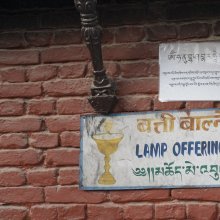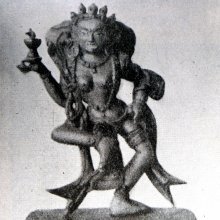Light: 3 definitions
Introduction:
Light means something in Hinduism, Sanskrit, Hindi. If you want to know the exact meaning, history, etymology or English translation of this term then check out the descriptions on this page. Add your comment or reference to a book if you want to contribute to this summary article.
Images (photo gallery)
(+29 more images available)
In Hinduism
Vedanta (school of philosophy)
Source: ORA: Amanaska (king of all yogas): (Advaita Vedanta)1) The Light of Gnosis (pervading everywhere) is denoted by the Sanskrit term Āloka, according to the Māṇḍūkyopaniṣatkārikā 3.35cd-36.—Accordingly, while discussing Brahma (without attributes): “That very [mind, free of thought and restrained,] is fearless Brahma, [which is] the light of gnosis (jñāna-āloka) [pervading] everywhere. [It is] unborn, devoid of sleep and dreaming, unnamed, formless, manifested [all] at once and omniscient. [This statement] is not figurative in any way”.
2) The Light (of Samādhi) can be denoted in the Sanskrit language as Jyotis, according to the Māṇḍūkyopaniṣatkārikā 3.37.—Accordingly, while discussing the no-mind state: “Devoid of all expression and having transcended all thought, Samādhi is very peaceful, its light (jyotis) perpetually [illuminates], [and it is] immovable and fearless”.

Vedanta (वेदान्त, vedānta) refers to a school of orthodox Hindu philosophy (astika), drawing its subject-matter from the Upanishads. There are a number of sub-schools of Vedanta, however all of them expound on the basic teaching of the ultimate reality (brahman) and liberation (moksha) of the individual soul (atman).
Yoga (school of philosophy)
Source: ORA: Amanaska (king of all yogas): A Critical Edition and Annotated Translation by Jason Birch1) The Light (of one’s own self) can be denoted by the Sanskrit term Jyotis, according to the Amanaska Yoga treatise dealing with meditation, absorption, yogic powers and liberation.—Accordingly, as Īśvara says to Vāmadeva: “[...] [Now], I shall define the nature of that highest, mind-free absorption which arises for those devoted to constant practice. [...] By means of an absorption for half a day, the light of his own self (svātma-jyotis) shines. Just like the sun shines forth with its [own] rays of light, the Yogin shines forth [and illuminates] the world. [...]”.
2) Light (i.e., lightness of body) can be denoted by the Sanskrit terms Laghu, according to the Bhāṣya (commentary) on the Pātañjalayogaśāstra Sūtra 3.42.—Accordingly, “... [The Yogin] who has mastered the connection [between body and space] becomes light (laghu). Because he is light (laghu), he can walk on water. Then, having walked on merely a spider’s thread, he walks on a ray of light. Then, he moves in the ether as he wishes”.

Yoga is originally considered a branch of Hindu philosophy (astika), but both ancient and modern Yoga combine the physical, mental and spiritual. Yoga teaches various physical techniques also known as āsanas (postures), used for various purposes (eg., meditation, contemplation, relaxation).
Languages of India and abroad
Hindi dictionary
Source: DDSA: A practical Hindi-English dictionaryLight in Hindi refers in English to:—(nf) light; ~[hausa] a light-house..—light (लाइट) is alternatively transliterated as Lāiṭa.
...
See also (Relevant definitions)
Starts with: Light african greenheart, Light blue, Light bosse, Light Kasina, Light of the world, Light wheat, Light yellow sophora, Light-stemmed commiphora, Lighting, Lightness, Lightning, Lightning bush, Lightwood, Rays of light.
Ends with: Delight, Fiery light, Great light, Moon-light, Orb of light, Rays of light.
Full-text (+5089): Rashmi, Laghu, Aloka, Amshu, Abhasa, Jyotis, Prabha, Bhanu, Rocis, Dipa, Mayukha, Ruci, Kirana, Ramanavami, Bhasvat, Prakasha, Vibha, Sthuma, Amshumala, Marici.
Relevant text
Search found 475 books and stories containing Light; (plurals include: Lights). You can also click to the full overview containing English textual excerpts. Below are direct links for the most relevant articles:
Brahma Sutras (Ramanuja) (by George Thibaut)
Sutra 1.4.13 < [First Adhyaya, Fourth Pada]
Sutra 1.3.41 < [First Adhyaya, Third Pada]
Sutra 1.4.9 < [First Adhyaya, Fourth Pada]
Mundaka Upanishad with Shankara’s Commentary (by S. Sitarama Sastri)
Verse 2.2.9 < [Mundaka II, Khanda II]
Verse 2.2.10 < [Mundaka II, Khanda II]
Verse 2.2.11 < [Mundaka II, Khanda II]
Prashna Upanishad with Shankara’s Commentary (by S. Sitarama Sastri)
Verse 1.6 < [Prashna I - The spiritual paths of the Moon and the Sun]
Verse 1.12 < [Prashna I - The spiritual paths of the Moon and the Sun]
Verse 4.2 < [Prashna IV - Mental states and Bliss]
Taittiriya Upanishad Bhashya Vartika (by R. Balasubramanian)
Verse 2.315 < [Book 2 - Brahmavallī]
Verse 2.254 < [Book 2 - Brahmavallī]
Verse 1.60 < [Book 1 - Śīkṣāvallī]
A Manual of Khshnoom (by Phiroz Nasarvanji Tavaria)
Mahabharata (English) (by Kisari Mohan Ganguli)
Section XCVIII < [Anusasanika Parva]
Section C < [Anusasanika Parva]
Section LXXI < [Sisupala-badha Parva]
Related products
(+139 more products available)











